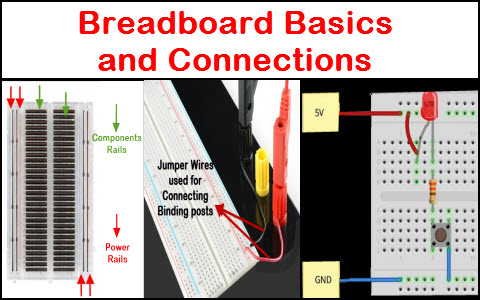
In electronics, prototyping is required,
which can be done using the soldering procedure, but it is not
economical, not reusable, and causes loss of electrical and electronics components.
Prototyping can be defined as creating a sample of a product or circuit
for testing, analyzing which is used for enhancing original product or
circuit. In this prototyping process, the components are connected
together by melting or using filler metal which is having a low melting
point compared to adjoining metals.
Thus, this soldering process used for
prototyping is uneconomical and not reusable. So, for prototyping a
construction base which can be used without any soldering is required
for economical, efficient, and reusing purpose. Hence, solderless
breadboard was designed in 1970s and is being used for prototyping of electronics.
In this article, let us know about breadboard basics, breadboard
connections, breadboard price, breadboard connections basics, how to use
breadboard for beginners, and who they are called so.
Breadboard Basics
In the 1960s, wire-wrap technique is used for designing, building, and testing the electronic circuits
and prototypes. Then, the larger boards (like wooden boards used for
bread slicing) were used onto which the components (huge electronics
elements) were connected using wires, pins or thumbtacks. Hence, these
are called as breadboards but, technical name of these circuit boards is
solderless breadboards. These solderless breadboards consist of holes
which are used for placing the component terminals and then these holes
are connected to each other using various wires.
Breadboard Connections Basics
If we see breadboard for the first time,
then we may feel it is very hard task to connect the circuit as it
consist of several holes which are a bit confusing. In fact, it is very
easy to connect the circuit if we understand the breadboard connections
basics. The first two rows (top) and last two rows (bottom) of the
breadboard are used for positive (one row of first and last two) and for
negative (another row of first and last two).
Here, the first (top) and last (bottom)
two rows of the breadboard consists of 5 holes in each column (totally
10 columns) are horizontally connected each other internally. If the
power source terminal is connected in one hole of one column on top or
bottom row (one of the two rows), then the same electric power
can be taken from the successive five holes in the same column. The
conductive layout diagram of the breadboard is shown in the figure
above.
Breadboard Connections
Let us know breadboard connections
basics such as how the rails are connected internally. The below figure
shows the internal connections of component rails and power rails.
In fact, the power rails can be connected by using jumper wires as shown in the figure below for obtaining same power supply
in both the rails. Here, the terminal indications plus and minus are
just for indication and there is no need for connecting power in “+”
indicated rail and ground into the “-” indicated rail.
The electronics beginners may get confused while connecting the DIP (Dual In-line Packages) components such as integrated circuits,
microcontrollers, chips, etc.,. The rails are isolated by ravine or
crevasse, thus the rows are not connected to each other on either side.
So, the DIP components can be connected as shown in the figure below.
There are various programs that can be used for building general circuits,
electronics projects circuits, etc., on a virtual breadboard. These
programs include Fritzing that facilitates the user to design the
circuits and also to test the circuit functionality.
Breadboard Price
Breadboard price varies with the type of
the breadboard. As there are various types of breadboards such as
builtin power supply breadboards, old type breadboard made from board of
bread, and so on. There are different types of breadboards available at
different costs, starting from Rs.50/- (approximately).
How to Use Breadboard for Beginners?
Let us discuss how to use breadboard for beginners, consider designing simple LED circuit
which makes the LED to glow using a power supply through a resistor for
controlling the power to LED. Connect the external power supply through
binding posts or directly from voltage source using jumping wires.
Then, connect these jumper wires to the LED through a resistor. Now,
switch ON the power supply and thus the LED glows. A push button is used
for connecting the resistor (second) terminal to the ground rail and
this push button can be used as switch to switch ON and OFF the LED. The
connections are shown in the figure below.
Thus, every electrical and electronics
projects circuit can be designed on breadboard. But, as the designing
complexity of the project circuit increases and consumes more time with
the increase in complexity of the project. There are advanced tools and
boards such as printed circuit boards, and so on for reducing the
designing complexities and save time.
Do you want to design and implement electronics projects on your own using breadboards? Then, post your views, comments, ideas, suggestions in the comments section below.

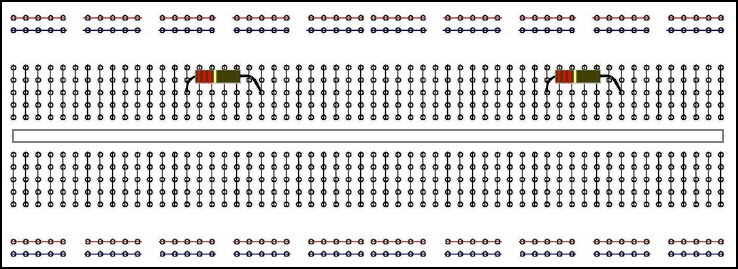
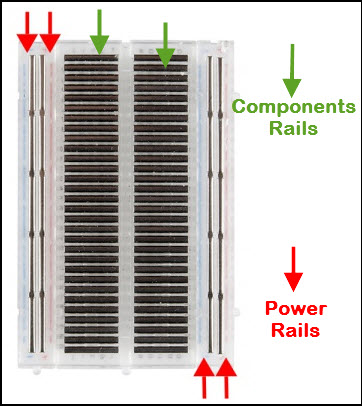
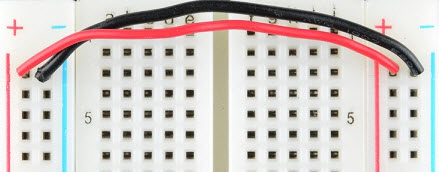
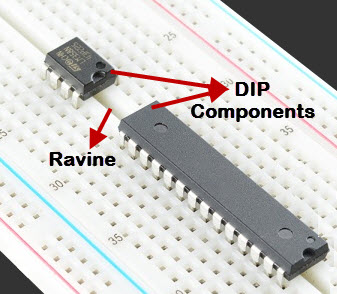
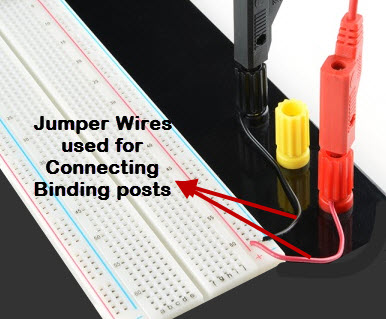
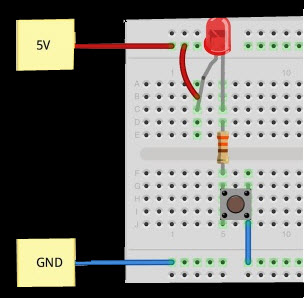
No comments:
Post a Comment